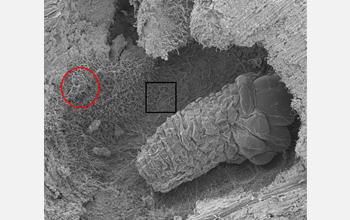All Images


Press Release 08-171
Beetles Get by With a Little Help From Their Friends

Cooperation between insects and bacteria suggests inter-species collaboration may be common in many ecosystems
Back to article | Note about images
 |
Southern pine beetles colonize pine trees and lay eggs in galleries within the tree bark. They line these galleries with spores of a beneficial fungus and a bacterium. Inadvertently, they can also bring along parasitic mites and spores of an antagonistic (competitor) fungus. The antagonist fungus competes to colonize the tree, but carries no nutritional value for the larvae. As the beneficial bacterium spreads, it produces an antibiotic that inhibits growth of the antagonistic fungus.
Credit: Zina Deretsky, National Science Foundation |
Download the high-resolution JPG version of the image. (845 KB)
|
Use your mouse to right-click (or Ctrl-click on a Mac) the link above and choose the option that will save the file or target to your computer.
|
 |
Adult southern pine beetle in flight.
Credit: Erich Vallery, USDA Forest Service Southern Research Station, Pineville, LA |
Download the high-resolution JPG version of the image. (281 KB)
|
Use your mouse to right-click (or Ctrl-click on a Mac) the link above and choose the option that will save the file or target to your computer.
|
 |
Southern pine beetle larva in a gallery, another name for the place where the beetles lay their eggs. Within the gallery, which is prepared by an adult female, you can see a "lawn" of filamentous microbes. On the left is the fungus found inside the tree bark (red circle). The larva feeds on this fungus. Between the fungus and the larva is another filamentous organism, which is the bacteria (black square).
Credit: M. Cetin Yuceer, Mississippi State University |
Download the high-resolution JPG version of the image. (204 KB)
|
Use your mouse to right-click (or Ctrl-click on a Mac) the link above and choose the option that will save the file or target to your computer.
|
 |
The researchers' findings are published in the Oct. 3, 2008, issue of Science magazine.
Credit: Copyright 2008 AAAS |
Download the high-resolution JPG version of the image. (1.3 MB)
|
Use your mouse to right-click (or Ctrl-click on a Mac) the link above and choose the option that will save the file or target to your computer.
|
|





